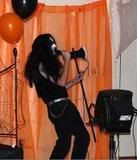So beings your quest to leave the mainstream and enter the world of stability and freedom (not as in free beer).
Below is a complete guide to installing and configuring your SuSE Linux 9.2 OS. I am going to assume (considering this is NT and most of us are ex/active EQ players) that most of you will have a cable / DSL connection.
Before you get started you need to decide on what you plan on doing with your system. You'll also need to decide if you're going to continue to play games or not. IF you do, then you'll need to plan on creating a partition for Windows (it's simply easier for beginners to just log into Windows to play their games until they become adept enough with Linux to configure it for their games). If you know enough, already, about Linux to configure such programs as WINE to play Windows based games - then you don't need this guide anyway. Secondly, if you don't know what a "partition" is, then you're better off not attempting to install Linux - until you've taken some time to learn about "computers."
I am going to take the long way around for certain points - just simplify the install for some folks.
First and foremost you'll need to get a copy of SuSE 9.2. I would suggest going to local book store (Barnes and Noble) and picking up a copy of Linux Fomat (it will cost you around 18 dollars and will have a complete DVD attached).
IF you plan on keeping a Windows patition for you games, then you'll have two basic options.
1. Use Partition Magic (or something of the like) and create a new patition that Linux will be installed on.
2. Format your hard drive with Windows and create TWO partitions during the install. Having a nice fresh install is not always a bad thing.
The choice is your and completely dependant on your abilities to use the partitioning software.
<center>Partition Magic</center>
I think the eval version (which is free) would be enough - you're only going to use it once...
Regardless, if you decide to format with Windows, or create a new partition with your choice of application - you should, at least, set create a partition of about 15 to 20 gigs for Linux (more if you have the hard drive space).
Again, if you have no intentions of using Windoze again - then disregard the above.
Ok.... now you've got your copy of Linux and you have your hard drive ready. Now it's time to install.
1. Insert your Linux installation disk and reboot your computer
2. Go into your BIOS and change your boot sequence to read your DVD / CD (which ever install media you have), save and exit.
3. You will see the Linux "Welcome" screen. THIS IS VERY SIMPLE. You'll watch the GUI as it begins the installation process. You are going to be asked "where" you want SuSE installed. IF you want a dual boot system, then tell SuSE to leave your C: drive (or where ever your Windows files are kept) alone. You'll see an "advanced" option at the bottom of the GUI when you are asked. Click on that option and select the partition you want Linux installed on. Then hit accept.
4. Keep following the install - it's self explanitory (you'll just be hitting next). Eventually, you are going to be asked to input a "root" password, this is where YOU make one up and put it in. REMEMBER THIS PASSWORD!
5. Once you've created your root password, simply continue with the installation by following the GUI. People, it's so easy that even George Bush can do it, without his staff telling him what button to push... really... it is.
6. Toward the end of the install you're going to be asked if you want SuSE to test your 'net connection. Just save yourself some time and select "skip" for now.
Once the installation is complete you're computer will reboot. Go into the BIOS and change your boot sequence back to what it was before (usually with the hard drive in the first slot).
You'll now see a different splash screen before you. There'll be a couple of options and you can select to either boot into Linux, or into Windows. Select Linux, of course.
Once you've booted into Linux - you'll see your desktop (it'll look like Windows sort of).
First, you'll want to ensure that you are connected to the net. Just click on the globe icon at the bottom left of your screen (in the tool bar) to open a browser... wow... there it is! The Internet and you didn't have to do anything.
Ok, now you've checked to ensure you have a net connection. Our next step is to update everything.
Click on the green botton at the very bottom left of your screen. Go to SYSTEM then YaST.
You'll now be asked to put in your root password (let's hope you remember it). Once you've put in your password you'll see a screen pop up before with several options. Simply select "Online Update." Then ACCEPT in the bottom right corner. Go get a drink, because it'll take a few minutes.
Once you're finished updating your Linux - you can now begin to install the rest of the goodies you'll want to use.
Open YaST again (just like when you opened it for your Online Update) - but this time you'll want to select Change Installation Source. Then you'll want to select "HTTP"
where it asks for the server you type: packman.iu-bremen.de
where it asks for directory you type: suse/9.2
Now press ACCEPT and close out of that box. Open "Install and Remove Software."
First we'll install a music player.
In the search field type "XMMS" and hit "Search" - you'll then see the application appear in the box in the right hand side of the form. Simply check the empty box next to it and select "ACCEPT" in the bottom right of the form. When it's finished select "Install More."
Now, we'll install a good video player (that can play WMV files).
This time in the search field type "Mplayer" and follow the same steps as just described above.
How about Gaim?
Follow the same steps, but type "Gaim" in the search field.
It's time to install Firefox.
In the search field type "Firefox" and again follow the same steps. This time select Finish when asked if you want to install more. Then exit out of YaST.
At this point you'll have: Open Office (which is installed during the update), a music player, a movie player, a good web browser, gaim (to chat with), and a graphics tool (Gimp is installed with your SuSE install - and is similar to Photoshop) to get you started.
Of course you're going to want to make a place to store your music and files right?
To do this (the simply way) click the green button in the bottom left of your screen and select "Switch User." Type in the word "root" in the login field and your root password (told you this was an important password) in the password field.
Then click on the "myComputer" icon on your desktop and click on the "usr" folder when it comes up. In the "usr" directory - right click and select "Create New Folder" and name it. Once it's made, right click on it and select "Properties" and then select "Permissions." In the bottom of the box change the "user" from "root" to your login name (you were asked to create a user account when you installed). Then select OK. Now you can read and write to this folder... Follow the same steps for all the folders you want to create. I, personally, have one for music, one for video and one for images.
Now go back to the green button (I'll refer to it as your start button from here on out) and select "Log out" then select "END SESSION." You'll be returned to your user account screen (where you left off).
Now you'll want to personalize your desktop. Like everything else you've just done - this is easy.
To create a shortcut to your music/whatever folders just right click on the desktop and select "Create New" --> File --> Link to URL" then in the URL field type the address of your folder "/usr/Music" or whatever you named it. Then hit OK. Simple as that.
You can change the icon of your shortcut by right clicking on it and clicking on the box holding the current icon. The rest is self explanitory.
To customize your desktop - simply right click on the desktop and select "Customize Desktop" -- you can then change the colors, background, size of icons... and more.
If you want to create a shortcut to your media players - you can do that too.
Right click on the desktop and select "Create New --> File --> Link to Application" and select "Application." Go to the command line and either type in the path, or select "Browse" and find the "exe" of your application.
They will typically be found in "bin" directories. Some will be in OPT --> Gnome... or OPT --> KDE.
I will provide more detail if need be.
To use your applications you can do one of two basic things... either:
Go to your Start button and select "command" and type the name of the application e.g. 'gaim' and hit ok.
or
You can make your shortcuts and just click on them.
That should be more than enough to get you up and going.
Spend some time learning your way around... spend time creating shortcuts...
If you kept your Windows install and have some music files you want to move over... no problem.. just click on myComputer and click on your C: drive - browse to where you keep your music there and copy and paste them to your newly created music folder in linux. Keep in mind that while you can see your Windows drive - you'll not be able to see your Linux drive from Windows.
And, finally - welcome to the community.
Guide to Installing SuSE Linux 9.2 (complete).
Moderator: Dictators in Training
4 posts • Page 1 of 1
SuSE install the NTFS modules by default? I know Fedora does not. Havn't tested SuSE on a machine with windows on it yet.
Would be good to know for those people who have NTFS windows partitions.
Would be good to know for those people who have NTFS windows partitions.
Last edited by Gidan on Thu Apr 28, 2005 10:25 am, edited 1 time in total.
For to win one hundred victories in one hundred battles is not the acme of skill. To subdue the enemy without fighting is the acme of skill.
-

Gidan - Admin Abuse Squad

- Posts: 2892
- Joined: Tue Jan 04, 2005 11:01 am
I am going to try this Linux stuff on my stereo/dvdplayer computer when I get around to it. The 6th annual Bellingham "Linuxfest" was held at the tech college here today, but its duration was my work schedule =(
fefn wrote:VIKING METAL 4TW ~_~
-

Witty - NT Veteran

- Posts: 1279
- Joined: Sat Mar 13, 2004 8:43 pm
- Location: Seattle
4 posts • Page 1 of 1
Who is online
Users browsing this forum: No registered users and 9 guests

